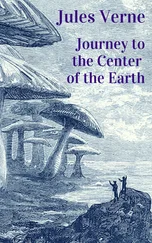They did more; they visited the gulf, now extinct, but in whose depths the rumbling could be distinctly heard. However, no sign of smoke or vapour, no heating of the rock, indicated an approaching eruption. But neither there, nor in any other part of Mount Franklin, did the colonists find any traces of him of whom they were in search.
Their investigations were then directed to the downs. They carefully examined the high lava-cliffs of Shark Gulf from the base to the crest, although it was extremely difficult to reach even the level of the gulf. No one!—nothing!
In short, in these two words was summed up so much fatigue uselessly expended, so much energy producing no result, that somewhat of anger mingled with the discomfiture of Cyrus Harding and his companions.
It was now time to think of returning, for these researches could not be prolonged indefinitely. The colonists were certainly right in believing that the mysterious being did not reside on the surface of the island, and the wildest fancies haunted their excited imaginations. Pencroft and Neb, particularly, were not contented with the mystery, but allowed their imaginations to wander into the domain of the supernatural.
On the 25th of February the colonists re-entered Granite House, and by means of the double cord, carried by an arrow to the threshold of the door, they re-established communication between their habitation and the ground.
A month later they commemorated, on the 25th of March, the third anniversary of their arrival on Lincoln Island.

Table of Contents
Three Years have passed—The new Vessel—What is agreed on—Prosperity of the Colony—The Dockyard—Cold of the Southern Hemisphere—Washing Linen—Mount Franklin.
Three years had passed away since the escape of the prisoners from Richmond, and how often during those three years had they spoken of their country, always present in their thoughts!
They had no doubt that the civil war was at an end, and to them it appeared impossible that the just cause of the North had not triumphed. But what had been the incidents of this terrible war? How much blood had it not cost? How many of their friends must have fallen in the struggle? They often spoke of these things, without as yet being able to foresee the day when they would be permitted once more to see their country. To return thither, were it but for a few days, to renew the social link with the inhabited world, to establish a communication between their native land and their island, then to pass the longest, perhaps the best, portion of their existence in this colony founded by them, and which would then be dependent of their country, was this a dream impossible to realise?
There were only two ways of accomplishing it—either a ship must appear off Lincoln Island, or the colonists must themselves build a vessel strong enough to sail to the nearest land.
“Unless,” said Pencroft, “our good genius himself provides us with the means of returning to our country.”
And, really, had any one told Pencroft and Neb that a ship of 300 tons was waiting for them in Shark Gulf or at Port Balloon, they would not even have made a gesture of surprise. In their state of mind nothing appeared improbable.
But Cyrus Harding, less confident, advised them to confine themselves to fact, and more especially so with regard to the building of a vessel—a really urgent work, since it was for the purpose of depositing, as soon as possible, at Tabor Island a document indicating Ayrton’s new residence.
As the Bonadventure no longer existed, six months at least would be required for the construction of a new vessel. Now winter was approaching, and the voyage could not be made before the following spring.
“We have time to get everything ready for the fine season,” remarked the engineer, who was consulting with Pencroft about these matters. “I think, therefore, my friend, that since we have to rebuild our vessel it will be best to give her larger dimensions. The arrival of the Scotch yacht at Tabor Island is very uncertain. It may even be that, having arrived several months ago, she has again sailed after having vainly searched for some trace of Ayrton. Will it not then be best to build a ship which, if necessary, could take us either to the Polynesian Archipelago or to New Zealand? What do you think?”
“I think, captain,” answered the sailor; “I think that you are as capable of building a large vessel as a small one. Neither the wood nor the tools are wanting. It is only a question of time.”
“And how many months would be required to build a vessel of from 250 to 300 tons?” asked Harding.
“Seven or eight months at least,” replied Pencroft. “But it must not be forgotten that winter is drawing near, and that in severe frost wood is difficult to work. We must calculate on several weeks’ delay, and if our vessel is ready by next November we may think ourselves very lucky.”
“Well,” replied Cyrus Harding, “that will be exactly the most favourable time for undertaking a voyage of any importance, either to Tabor Island or to a more distant land.”
“So it will, captain,” answered the sailor. “Make out your plans then; the workmen are ready, and I imagine that Ayrton can lend us a good helping hand.”
The colonists, having been consulted, approved the engineer’s plan, and it was, indeed, the best thing to be done. It is true that the construction of a ship of from two to three hundred tons would be great labour, but the colonists had confidence in themselves, justified by their previous success.
Cyrus Harding then busied himself in drawing the plan of the vessel and making the model. During this time his companions employed themselves in felling and carting trees to furnish the ribs, timbers, and planks. The forest of the Far West supplied the best oaks and elms. They took advantage of the opening already made on their last excursion to form a practicable road, which they named the Far West Road, and the trees were carried to the Chimneys, where the dockyard was established. As to the road in question, the choice of trees had rendered its direction somewhat capricious, but that at the same time facilitated the access to a large part of the Serpentine Peninsula.
It was important that the trees should be quickly felled and cut up, for they could not be used while yet green, and some time was necessary to allow them to get seasoned. The carpenters, therefore, worked vigorously during the month of April, which was troubled only by a few equinoctial gales of some violence. Master Jup aided them dexterously, either by climbing to the top of a tree to fasten the ropes or by lending his stout shoulders to carry the lopped trunks.
All this timber was piled up under a large shed, built near the Chimneys, and there awaited the time for use.
The month of April was tolerably fine, as October often is in the northern zone. At the same time other work was actively continued, and soon all trace of devastation disappeared from the plateau of Prospect Heights. The mill was rebuilt, and new buildings rose in the poultry-yard. It had appeared necessary to enlarge their dimensions, for the feathered population had increased considerably. The stable now contained five onagas, four of which were well broken, and allowed themselves to be either driven or ridden, and a little colt. The colony now possessed a plough, to which the onagas were yoked like regular Yorkshire or Kentucky oxen. The colonists divided their work, and their arms never tired. Then who could have enjoyed better health than these workers, and what good humour enlivened the evenings in Granite House as they formed a thousand plans for the future!
Читать дальше













